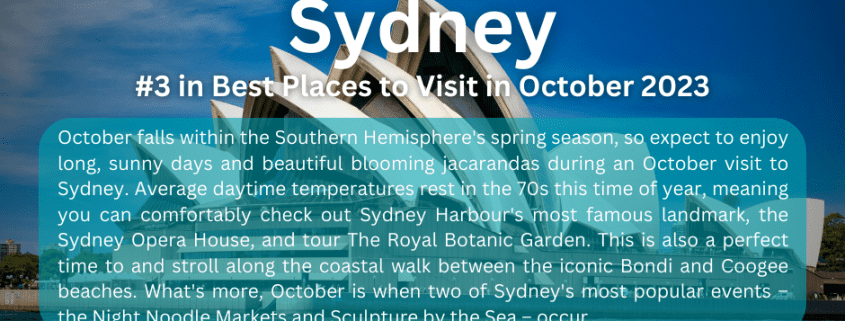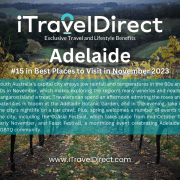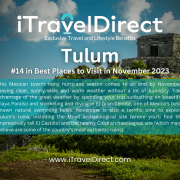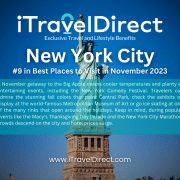Sydney #3 in Best Places to Visit in October 2023
Why Go To Sydney
Sydney is both a laid-back beachside city and a thriving metropolis that boasts some of the Southern Hemisphere’s best surf, landmarks and activities. Whether you’re looking to watch a show at the iconic Sydney Opera House, take to the waves at Bondi Beach or explore trendy areas like The Rocks and Darling Harbour, Sydney features something for everyone. Even Sydneysiders have an ideal mix of both worlds: Fashion-forward attire combines with a relaxed coastal vibe and “no worries” attitude. It’s no wonder this vibrant city down under is a natural choice for first-time Aussie visitors.
In addition to tons of beaches and top-notch restaurants and bars, Australia’s most populous city features an array of things to do. Thrill-seekers can participate in heart-pounding activities like a Sydney Harbour Bridge climb, while visitors looking to unwind will appreciate a relaxing day at Coogee or Manly Beach or a peaceful stroll through the Royal Botanic Garden. There’s also plenty of seasonal Sydney festivals and events to experience, such as Sculpture by the Sea, Vivid Sydney and the Night Noodle Markets. Whether you’re looking to enjoy a rugby match, hit up the city’s museums or lounge along the shore, Sydney’s got you covered.
Best Months to Visit
The best times to visit Sydney are September through November and from March to May. These months skirt Sydney’s high and low seasons, offering visitors comfortable temperatures and manageable tourist crowds. Plus, airline prices fall during these shoulder seasons, making it more affordable to visit in the spring and fall. Thanks to Australia’s location in the Southern Hemisphere, Sydney’s warmest weather and peak tourist season falls between December and February (winter in the Northern Hemisphere). Consequently, the region’s low season starts in May and lasts through August.
Culture & Customs
Although racism against indigenous Australians and nonwhite immigrants was once legally enforced through the country’s White Australia Policy, today, Sydneysiders welcome immigrants and tourists from all over the world. In fact, this down under city is so diverse that it has become a melting pot for the arts, religion, music and cuisine.
Despite its size, Australia’s most populated city has earned a reputation for being laid-back and friendly. However, much like their British counterparts, Aussies are known for their sarcasm and frank remarks. But, if you can move past Sydneysiders’ lewd lingo, navigating this Australian city is relatively easy, thanks to the country’s use of English. Try brushing up on your Aussie slang, though, before arriving. Key phrases to know are “fair dinkum” (true or genuine), “g’day” (hello) and “I reckon” (for sure). And like other major cities, keep a close eye on your belongings, especially in tourist areas where pickpockets are known to target foreigners.
Also, keep in mind Australia’s driving culture. Similar to other former British colonies like South Africa, Guyana and India, Aussies drive on the left side of the road. As a result, pedestrians should look to the right, then the left and then right again before crossing the street. Visitors traveling by taxi should also note that tips are not required. Many cab drivers, though, will try coercing customers into providing a tip; refrain from providing gratuity when getting around by taxi. Tips are also not required when dining out at restaurants unless exceptional service is provided.
All Australian cities, including Sydney, use the Australian dollar (1 Australian dollar is equal to $0.65). Like any exchange rate, the Australian to U.S. dollar rate can fluctuate, so check the latest exchange rate before you visit.
What to Eat
With sizable European and Asian immigrant populations, it’s hardly surprising that much of Sydney’s cuisine features elements of other cultures’ food traditions. The city also features multiple ethnic-specific districts, such as Haymarket’s Chinatown area, the Italian-centric Leichhardt and Little Saigon in Cabramatta.
If you’d rather forgo the region’s global cuisine in favor of something more Australian, you may struggle to find it. Much of modern Australian fare has been influenced by other cultures, so you won’t find many dishes without international ties. However, an important component of Aussie cuisine is meat, thanks in part to the country’s thriving cattle industry. And because Sydney sits on the water, seafood also holds a prominent role in Sydneysiders’ diets.
Notable local delicacies include meat pies (a meat and gravy-stuffed baked pastry), damper (soda bread traditionally made over a campfire) and Vegemite (a bitter yeast spread added to toast for breakfast). For something sweeter, Sydneysiders gravitate toward ANZAC biscuits (a sweet cookie originally created by soldiers’ wives during World War I), Tim Tams (a chocolate covered cookie that comes in an array of flavors) and lamingtons (a chocolate- and coconut- crusted sponge cake).
In addition to Sydney’s abundant restaurants, bars and cafes, visitors can savor top-notch dishes at seasonal food festivals. If visiting in October, check out Sydney’s Night Noodle Markets, which feature 50 authentic Asian food stalls near Hyde Park. And bakers can’t miss a chance to experience the three-day Cake, Bake and Sweets Show held every September.
Getting Around Sydney
The best way to get around Sydney is by Sydney Trains, which has rail lines that are easy for first-time users to navigate. Although the bus system has routes that crisscross the city, any traveling done on four wheels is at the mercy of Sydney traffic. Rental cars are recommended for driving to and from the city, but not inside its boundaries since traffic is heavy and Aussies drive on the left side of the road, which can be confusing to American visitors. Walking is a wonderful way to explore parts of the inner city. And a trip on a ferry is a must-do for the views alone.
To get to and from Sydney Airport (SYD), you can take a taxi, use shared ride apps, catch the 420 bus or hop on the Airport Link train, which takes you about 6 miles into the city. You can also rent a car at the airport. A taxi or rideshare ride from the airport to the central business district will typically cost between AU$45 and AU$55 (about $31 to $38).
Sydney Trains
With a convenient light rail and train network that’s tourist-friendly and reliable, it’s no wonder why the Sydney Trains system is popular with locals and visitors alike. Many attractions, including the Sydney Opera House, The Rocks and the Royal Botanic Garden, can be accessed from central lines, while other lines travel to the Blue Mountains and along the South Coast. Fares vary based on distance and time traveled, and discounts are available for senior citizens and children. Single trip tickets can be used, but for a more hassle-free fare option that works on all of Sydney’s trains, light rails, buses and ferries, purchase an Opal card, a reloadable plastic card that riders can transfer money onto online, at select retailers or at Opal train station vending machines. Most train lines operate from 4:30 a.m. to midnight with certain services running overnight.
Bus
Sydney’s public buses are a fairly reliable form of transportation and convenient way to get to just about everywhere in the city, even its outskirts. But because Sydney is such a big and bustling place, the buses do encounter frequent traffic jams and delays, particularly during rush hour. Fares are based on distance traveled. A single, one-way adult fare for trips between zero and 3 kilometers costs between AU$2.24 and AU$4 (around $1.50 to $2.70), depending on if you have an Opal card or a single Opal ticket and whether you’re traveling off-peak. You can also use an Opal card on Sydney’s buses and other forms of local transportation.
Ferry
If you’re looking to get to Manly Beach or Darling Harbour, or just want to enjoy the best views of Sydney Harbour, riding one of Sydney Ferries’ vessels is a must. You’ll find the main ferry terminal at Circular Quay, where 10 ferry lines depart throughout the day and evening. Make sure to leave plenty of time to arrive at the ferry dock since wharf gates close 2 minutes before scheduled departure times.
One-way fares vary based on the destination but start at AU$6.43 (or $4.40) for adults. A reloadable Opal card, Opal single trip ticket or credit card can be used to pay for most ferry rides. Discounts are also available for seniors, students and children.
Car
If you’re planning to visit multiple Aussie cities or want to take a day trip outside of Sydney, consider renting a car. However, for those who plan on staying within the city, a car will become an expensive, inefficient hassle. Not only is parking pricey and hard to come by, but traffic is unrelenting. Add in the cost of a rental and the price of gas, and you’ll end up paying big money for a big headache. If you do decide to drive, keep in mind that traffic operates on the left side of the road and all cars use right-hand drive (meaning the steering wheel is on the right).
Taxi
In Sydney, taxi fare is determined by the number of kilometers traveled, so you might find the fares higher than in the U.S. Plus, during peak hours and on weekends, additional surcharges or hiked fares may apply. To hail a taxi, signal for one on the street or make an advance reservation by phone (much like you would in America). Expect to pay about AU$2.19 (roughly $1.50) per kilometer during the day. Ride-hailing apps like Uber and women-only Shebah also operate in Sydney.
On Foot
When in doubt, hoof it. If you’re armed with a good map, then walking can be a great way to see Sydney’s individual neighborhoods. However, this sprawling city is way too large to traverse entirely on foot. When you get tired (and you will), hop on another mode of transit.
Entry & Exit Requirements
You must have a valid U.S. passport to enter Australia. Americans are welcome to stay for up to 90 days as long as an Electronic Travel Authority (ETA) is acquired. ETAs are electronic visas and can be obtained; airlines and travel agents may also apply for ETAs on your behalf. For more information, visit the U.S. State Department’s website.
Start Saving with iTravelDirect’s Exclusive Travel and Lifestyle Benefits Membership
CLICK HERE to Test-Drive our Guaranteed Savings
We offer a 110% Price Guarantee – Find a lower price anywhere online and we will refund you 110% of the difference.
CLICK HERE for a full list of services and Membership Discounts.
When you join iTravelDirect, you’ll have full access to all club benefits.
Your membership gives you the freedom to travel when you want, to where you want.
And you won’t find lower rates anywhere, guaranteed. So, pack your bags and start planning that vacation of a lifetime today!












Leave a Reply
Want to join the discussion?Feel free to contribute!